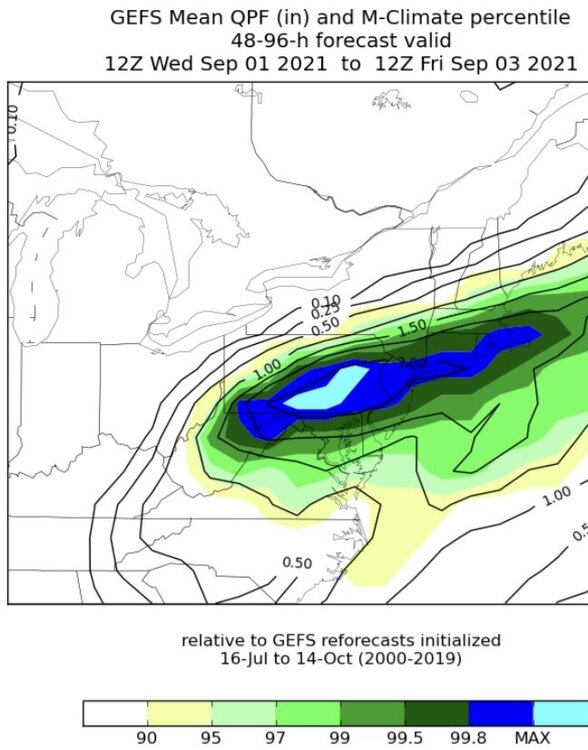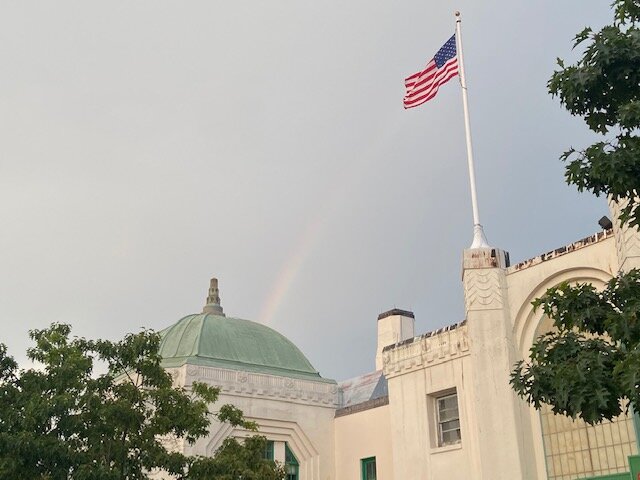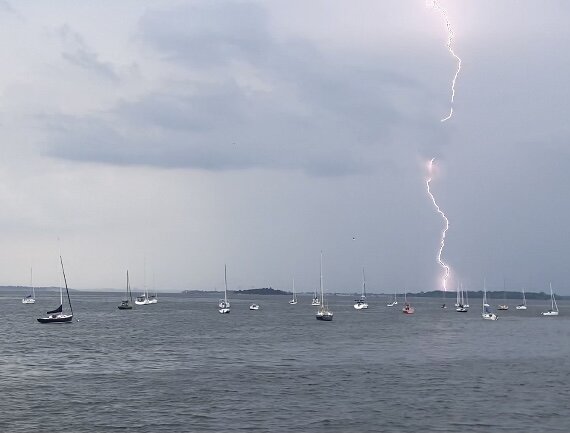-
Posts
23,219 -
Joined
Content Type
Profiles
Blogs
Forums
American Weather
Media Demo
Store
Gallery
Everything posted by donsutherland1
-
I am not yet confident about the winter. How warm Region 1+2 is relative to Region 3.4 could make a big difference in the winter outcome.
-
- 511 replies
-
- 2
-

-
- heavy rain
- tropical gusts
-
(and 1 more)
Tagged with:
-
Temperatures rose well into the 80s today in many parts of the region. Newark reached 90° for the 40th day this year and Baltimore reached 90° for the 50th time this year. Clouds will increase tomorrow ahead of moisture streaming northward from the remnants of IDA. It will be a warm day. Some locations could pick up a shower or thunderstorm. Wednesday into Thursday will be cloudy with heavy rain likely. Much of the region will see a general 2"-4" of rain with local amounts at or above 6". Flash flooding is likely on account of the saturated ground from excessive August rainfall. Overall, September will likely feature near normal to somewhat warmer than normal temperatures in much of the region. Fall 2021 will likely be wetter to much wetter than normal in the northern Middle Atlantic region. Since 1869, there have been 9 August cases where New York City picked up 20.00" or more rainfall during the summer. Two thirds of those cases (and 4/5 of those with summer mean temperatures of 73.0° or above) had 17.00" or more fall precipitation in New York City. 2011 is probably the closest match in terms of precipitation and a nearly identical summer mean temperature. Mean fall precipitation for those 9 cases was 14.86". The median was 17.35". The 1991-2020 normal value is 12.27". The ENSO Region 1+2 anomaly was 0.0°C and the Region 3.4 anomaly was -0.3°C for the week centered around August 25. For the past six weeks, the ENSO Region 1+2 anomaly has averaged +0.35°C and the ENSO Region 3.4 anomaly has averaged -0.47°C. Neutral ENSO conditions will likely prevail into at least mid-September. Afterward, La Niña conditions could begin to develop. The SOI was +28.22 today. The preliminary Arctic Oscillation (AO) figure was -1.399 today. On August 28 the MJO was in Phase 2 at an amplitude of 1.375 (RMM). The August 27-adjusted amplitude was 1.351 (RMM). Based on sensitivity analysis applied to the latest guidance, there is an implied near 100% probability that New York City will have a warmer than normal August (1991-2020 normal). August will likely finish with a mean temperature near 77.5° (1.5° above normal). Finally, with the Arctic Oscillation having turned negative, Arctic sea ice extent (JAXA) will likely fall below 5 million square kilometers for the first time this year in tonight's report for August 30.
-
-
Morning thoughts… Today will be partly cloudy and warmer. A shower is possible in a few places, but most of the region should be dry. High temperatures will likely reach the middle and upper 80s in most of the region. Likely high temperatures around the region include: New York City (Central Park): 84° Newark: 88° Philadelphia: 88° Normals: New York City: 30-Year: 81.3°; 15-Year: 81.2° Newark: 30-Year: 82.7°; 15-Year: 82.7° Philadelphia: 30-Year: 83.9°; 15-Year: 83.6° Heavy rain from the remnants of Ida will likely impact the Middle Atlantic and southern New England regions during midweek. A general 2”-4” of rain with locally higher amounts is likely.
-
Tomorrow will be partly sunny and warmer. A few locations could see a shower or two. Looking farther ahead, September will likely feature near normal to somewhat warmer than normal temperatures overall. Ida is continuing to batter Louisiana after having made landfall with maximum sustained winds of 150 mph. Ida will slowly move away from New Orleans overnight, but not before dumping additional heavy rain and inflicting further wind-driven damage. Fall 2021 will likely be wetter to much wetter than normal in the northern Middle Atlantic region. Since 1869, there have been 9 August cases where New York City picked up 20.00" or more rainfall during the summer. Two thirds of those cases (and 4/5 of those with summer mean temperatures of 73.0° or above) had 17.00" or more fall precipitation in New York City. 2011 is probably the closest match in terms of precipitation and a nearly identical summer mean temperature. Mean fall precipitation for those 9 cases was 14.86". The median was 17.35". The 1991-2020 normal value is 12.27". The ENSO Region 1+2 anomaly was -0.1°C and the Region 3.4 anomaly was -0.9°C for the week centered around August 18. For the past six weeks, the ENSO Region 1+2 anomaly has averaged +0.41°C and the ENSO Region 3.4 anomaly has averaged -0.43°C. Neutral ENSO conditions will likely prevail into mid-September. Afterward, La Niña could begin to develop. The SOI was +13.59 today. The preliminary Arctic Oscillation (AO) figure was -0.963 today. On August 27 the MJO was in Phase 2 at an amplitude of 1.349 (RMM). The August 26-adjusted amplitude was 1.291 (RMM). Based on sensitivity analysis applied to the latest guidance, there is an implied near 100% probability that New York City will have a warmer than normal August (1991-2020 normal). August will likely finish with a mean temperature near 77.6° (1.6° above normal).
-
I am not sure. After all, we categorize them as major hurricanes at Cat. 3
-
Morning thoughts… Today will be variably cloudy, breezy, and a bit warmer. A shower is possible, especially in western parts of the region. High temperatures will likely reach the upper 70s and lower 80s. Likely high temperatures around the region include: New York City (Central Park): 77° Newark: 81° Philadelphia: 82° Normals: New York City: 30-Year: 81.5°; 15-Year: 81.3° Newark: 30-Year: 82.9°; 15-Year: 82.9° Philadelphia: 30-Year: 84.1°; 15-Year: 83.8° Powerful Hurricane Ida will make landfall along the Louisiana coast as a Category 4 hurricane. There is a small possibility that it could peak as a category 5 hurricane near or during landfall. Its rains will likely impact the Middle Atlantic region during midweek.
-
Today was mainly cloudy and cool in the New York City area. Parts of Suffolk County picked up 3"-6" of rain. Philadelphia also picked up a daily record 3.17" (old record: 2.33", 1978). During the 2000-21 period, Philadelphia has averaged 0.9 days per year during which 3" or more of precipitation was recorded. That is triple the annual average for the 1872-1999 period. Tomorrow will be variably cloudy and a bit warmer. A few locations could see a shower or two. Looking farther ahead, September will likely feature near normal to somewhat warmer than normal temperatures overall. Ida will likely make landfall along the Louisiana coast as a Category 4 hurricane. A widespread 10"-15" rainfall with locally higher amounts is likely along its path. Fall 2021 will likely be wetter to much wetter than normal in the northern Middle Atlantic region. Since 1869, there have been 9 August cases where New York City picked up 20.00" or more rainfall during the summer. Two thirds of those cases (and 4/5 of those with summer mean temperatures of 73.0° or above) had 17.00" or more fall precipitation in New York City. 2011 is probably the closest match in terms of precipitation and a nearly identical summer mean temperature. Mean fall precipitation for those 9 cases was 14.86". The median was 17.35". The 1991-2020 normal value is 12.27". The ENSO Region 1+2 anomaly was -0.1°C and the Region 3.4 anomaly was -0.9°C for the week centered around August 18. For the past six weeks, the ENSO Region 1+2 anomaly has averaged +0.41°C and the ENSO Region 3.4 anomaly has averaged -0.43°C. Neutral ENSO conditions will likely prevail into mid-September. Afterward, La Niña could begin to develop. The SOI was +4.43 today. The preliminary Arctic Oscillation (AO) figure was -0.662 today. On August 26 the MJO was in Phase 2 at an amplitude of 0.1.291 (RMM). The August 25-adjusted amplitude was 0.752 (RMM). Based on sensitivity analysis applied to the latest guidance, there is an implied near 100% probability that New York City will have a warmer than normal August (1991-2020 normal). August will likely finish with a mean temperature near 77.6° (1.6° above normal).
-
it was cloudy, breezy, and cool today in the New York Botanical Garden. The temperature was in the 70s throughout the afternoon.
-
Here’s some other data: Threshold Search for Maximum Temperature (F) New York-Kennedy Airport Area (NY) JFKthr 9 Lat/Lon/Elev: / / Years: 1990 to 2021 Dates: 01-01 to 12-31 Condition is: Maximum Temperature (F) greater than or equal to 90 To sort multiple columns, hold SHIFT while clicking on the columns. Year Jan Feb Mar Apr May Jun Jul Aug* Sep Oct Nov Dec Annual 1990 0 0 0 0 0 0 5 1 0 0 0 0 6 1991 0 0 0 0 3 4 6 3 1 0 0 0 17 1992 0 0 0 0 1 0 5 0 0 0 0 0 6 1993 0 0 0 0 0 1 8 2 2 0 0 0 13 1994 0 0 0 0 0 2 5 0 0 0 0 0 7 1995 0 0 0 0 0 3 4 8 0 0 0 0 15 1996 0 0 0 0 2 1 0 0 1 0 0 0 4 1997 0 0 0 0 0 3 5 2 0 0 0 0 10 1998 0 0 0 0 0 1 2 1 1 0 0 0 5 1999 0 0 0 0 0 2 11 1 0 0 0 0 14 2000 0 0 0 0 0 2 2 2 0 0 0 0 6 2001 0 0 0 0 0 3 1 4 0 0 0 0 8 2002 0 0 0 1 0 3 11 6 0 0 0 0 21 2003 0 0 0 0 0 4 4 4 0 0 0 0 12 2004 0 0 0 0 0 1 0 0 0 0 0 0 1 2005 0 0 0 0 0 1 5 10 1 0 0 0 17 2006 0 0 0 0 0 0 6 6 0 0 0 0 12 2007 0 0 0 0 0 1 1 4 0 1 0 0 7 2008 0 0 0 0 0 4 4 1 0 0 0 0 9 2009 0 0 0 0 0 0 1 5 0 0 0 0 6 2010 0 0 0 0 1 8 13 8 2 0 0 0 32 2011 0 0 0 0 0 1 10 2 0 0 0 0 13 2012 0 0 0 0 0 5 8 2 1 0 0 0 16 2013 0 0 0 0 0 2 7 0 0 0 0 0 9 2014 0 0 0 0 0 1 0 0 1 0 0 0 2 2015 0 0 0 0 0 1 3 6 2 0 0 0 12 2016 0 0 0 0 0 1 7 6 1 0 0 0 15 2017 0 0 0 0 1 2 5 0 1 0 0 0 9 2018 0 0 0 0 0 1 2 4 1 0 0 0 8 2019 0 0 0 0 0 1 5 0 0 1 0 0 7 2020 0 0 0 0 0 0 10 2 0 0 0 0 12 2021 0 0 0 0 2 3 1 4 - - - - 10
-
With the recent upgrade to NWS data, one can go here, choose JFK and then “first-last” dates. https://www.weather.gov/wrh/Climate?wfo=okx First-last 90F readings JFK: Date First Last 2000 Jun-10 (2000) Aug-08 (2000) 2001 Jun-27 (2001) Aug-10 (2001) 2002 Apr-17 (2002) Aug-18 (2002) 2003 Jun-24 (2003) Aug-27 (2003) 2004 Jun-09 (2004) Jun-09 (2004) 2005 Jun-14 (2005) Sep-12 (2005) 2006 Jul-02 (2006) Aug-20 (2006) 2007 Jun-17 (2007) Oct-08 (2007) 2008 Jun-08 (2008) Aug-06 (2008) 2009 Jul-30 (2009) Aug-19 (2009) 2010 May-26 (2010) Sep-08 (2010) 2011 Jun-09 (2011) Aug-08 (2011) 2012 Jun-20 (2012) Sep-01 (2012) 2013 Jun-24 (2013) Jul-20 (2013) 2014 Jun-18 (2014) Sep-02 (2014) 2015 Jun-21 (2015) Sep-08 (2015) 2016 Jun-22 (2016) Sep-09 (2016) 2017 May-19 (2017) Sep-24 (2017) 2018 Jun-29 (2018) Sep-04 (2018) 2019 Jun-27 (2019) Oct-02 (2019) 2020 Jul-02 (2020) Aug-27 (2020)
-
In southern Westchester, it is partly sunny and breezy right now.
-
Morning thoughts… At 7:15 am, rain was continuing to fall in parts of Suffolk County. Flash flooding was reported at Nesconset (1 SE), Saint James (1 S), and Saint James (1 SSE). Islip had also picked up 1.20” of rain in a one-hour period. Today will be mostly cloudy, breezy, and noticeably cooler. Showers and periods of rain are likely. Some areas of heavy rain are possible in parts of the region this morning. High temperatures will likely reach the middle and upper 70s. Likely high temperatures around the region include: New York City (Central Park): 75° Newark: 78° Philadelphia: 79° Normals: New York City: 30-Year: 81.7°; 15-Year: 81.5° Newark: 30-Year: 83.1°; 15-Year: 83.1° Philadelphia: 30-Year: 84.3°; 15-Year: 83.9° Late tomorrow, Hurricane Ida will likely make landfall along the Louisiana coast as a strong Category 4 hurricane. Some of its rains could affect the Middle Atlantic region during the middle of next week.
-
A front will move slowly through the region and it could stall nearby tonight and tomorrow. The result will be cooler weather with potential showers and thundershowers tonight and tomorrow. Drier air could arrive for Sunday. Looking farther ahead, September will likely feature near normal to somewhat warmer than normal temperatures overall. Meanwhile Tropical Storm Ida has now developed. Ida will pose a threat to the U.S. Gulf Coast late Sunday into Monday. Some of the guidance has it making landfall as a Category 3 or Category 4 hurricane. Through 7 pm CDT, New Orleans has received 65.74" of rain. That is the 2nd highest figure on record for this time of year. As a result, the already saturated ground could exacerbate the risk of flooding from Ida. Fall 2021 will likely be wetter to much wetter than normal in the northern Middle Atlantic region. Since 1869, there have been 9 August cases where New York City picked up 20.00" or more rainfall during the summer. Two thirds of those cases (and 4/5 of those with summer mean temperatures of 73.0° or above) had 17.00" or more fall precipitation in New York City. 2011 is probably the closest match in terms of precipitation and a nearly identical summer mean temperature. Mean fall precipitation for those 9 cases was 14.86". The median was 17.35". The 1991-2020 normal value is 12.27". The ENSO Region 1+2 anomaly was -0.1°C and the Region 3.4 anomaly was -0.9°C for the week centered around August 18. For the past six weeks, the ENSO Region 1+2 anomaly has averaged +0.41°C and the ENSO Region 3.4 anomaly has averaged -0.43°C. Neutral ENSO conditions will likely prevail into mid-September. Afterward, La Niña could begin to develop. The SOI was +5.95 today. The preliminary Arctic Oscillation (AO) figure was -0.572 today. On August 25 the MJO was in Phase 2 at an amplitude of 0.760 (RMM). The August 24-adjusted amplitude was 0.478 (RMM). Based on sensitivity analysis applied to the latest guidance, there is an implied 98% probability that New York City will have a warmer than normal August (1991-2020 normal). August will likely finish with a mean temperature near 77.6° (1.6° above normal).
-
I believe that’s it.
-
No. Dingmans Ferry actually referred to a bridge.
-
This is true. I go there often, as I have a sister who lives in the Dingmans Ferry area.
-
Islip hit 93° so far. That broke the daily record of 92°, which was set just last year.
-

Flash flood potential 2PM Fri Aug 27-2PM Sat Aug 28
donsutherland1 replied to wdrag's topic in New York City Metro
Flood Watch National Weather Service New York NY 1151 AM EDT Fri Aug 27 2021 NYZ069-071>075-176-178-280500- /O.EXA.KOKX.FF.A.0007.210827T1800Z-210829T0600Z/ /00000.0.ER.000000T0000Z.000000T0000Z.000000T0000Z.OO/ Rockland-Southern Westchester-New York (Manhattan)-Bronx- Richmond (Staten Island)-Kings (Brooklyn)-Northern Queens- Southern Queens- 1151 AM EDT Fri Aug 27 2021 ...FLASH FLOOD WATCH IN EFFECT THROUGH LATE SATURDAY NIGHT... The National Weather Service in Upton has expanded the * Flash Flood Watch to include a portion of southeast New York, including the following areas, Bronx, Kings (Brooklyn), New York (Manhattan), Northern Queens, Richmond (Staten Island), Rockland, Southern Queens, and Southern Westchester. * Through late Saturday night * A moist environment could result in heavy rain producing thunderstorms this afternoon into Saturday night. With recent heavy rainfall, it will not take much additional rain to result in flash flooding. The greatest risk looks to be this afternoon through Saturday afternoon. * Rainfall rates of 1 to 2 inches per hour could result in flash flooding, especially in low-lying and poor drainage areas such as highway underpasses. PRECAUTIONARY/PREPAREDNESS ACTIONS... You should monitor later forecasts and be prepared to take action should Flash Flood Warnings be issued. && -
Morning thoughts… Today will be partly sunny and hot. The risk of showers and thundershowers will increase during the afternoon and evening. High temperatures will likely reach the upper 80s and lower 90s in most of the region. Likely high temperatures around the region include: New York City (Central Park): 90° Newark: 93° Philadelphia: 92° Normals: New York City: 30-Year: 81.9°; 15-Year: 81.7° Newark: 30-Year: 83.3°; 15-Year: 83.3° Philadelphia: 30-Year: 84.5°; 15-Year: 84.1° A cooler and occasionally wet weekend lies ahead.
-
One more hot day lies ahead. Afterward, a front will move slowly through the region and it could stall nearby. The result will be cooler weather with potential showers and thundershowers during the weekend. Meanwhile Tropical Storm Ida has now developed. Ida will pose a threat to the U.S. Gulf Coast early next week. Some of the guidance has it making landfall as a Category 2 or Category 3 hurricane. Through 7 pm CDT, New Orleans has received 65.74" of rain. That is the 2nd highest figure on record for this time of year. As a result, the already saturated ground could exacerbate the risk of flooding from Ida. Fall 2021 will likely be wetter to much wetter than normal in the northern Middle Atlantic region. Since 1869, there have been 9 August cases where New York City picked up 20.00" or more rainfall during the summer. Two thirds of those cases (and 4/5 of those with summer mean temperatures of 73.0° or above) had 17.00" or more fall precipitation in New York City. 2011 is probably the closest match in terms of precipitation and a nearly identical summer mean temperature. Mean fall precipitation for those 9 cases was 14.86". The median was 17.35". The 1991-2020 normal value is 12.27". The ENSO Region 1+2 anomaly was -0.1°C and the Region 3.4 anomaly was -0.9°C for the week centered around August 18. For the past six weeks, the ENSO Region 1+2 anomaly has averaged +0.41°C and the ENSO Region 3.4 anomaly has averaged -0.43°C. Neutral ENSO conditions will likely prevail into mid-September. Afterward, La Niña could begin to develop. The SOI was +5.83 today. The preliminary Arctic Oscillation (AO) figure was -0.640 today. On August 24 the MJO was in Phase 2 at an amplitude of 0.489 (RMM). The August 23-adjusted amplitude was 0.553 (RMM). Based on sensitivity analysis applied to the latest guidance, there is an implied 96% probability that New York City will have a warmer than normal August (1991-2020 normal). August will likely finish with a mean temperature near 77.4° (1.4° above normal).








